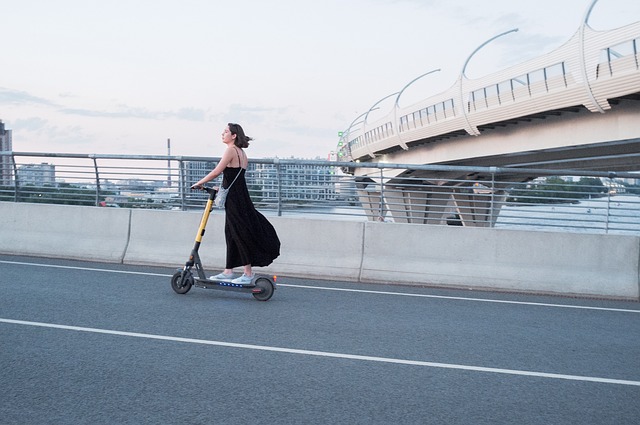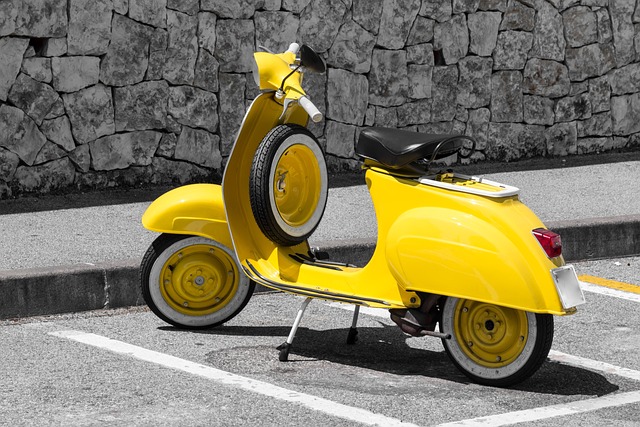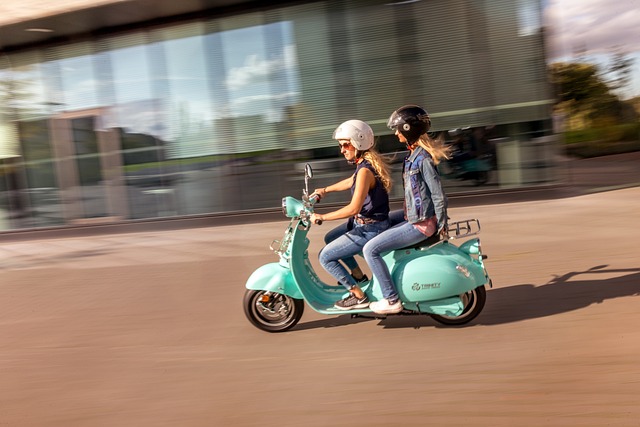Electric scooters for adults have emerged as a key sustainable transport option in urban areas, offering an eco-friendly alternative to cars. Their environmental benefits, due to zero emissions and energy efficiency, are significant, aiding in the reduction of air pollution and greenhouse gases. The advanced battery technology used in these scooters has extended their range and longevity, making them suitable for daily commutes as well as recreational use. Top brands like Segway, Xiaomi, and Hoverbed lead the market with reliable and stylish models that cater to a variety of needs. Safety, compliance with local regulations, and infrastructure development are crucial for the responsible operation of electric scooters. Cities are increasingly investing in dedicated lanes and charging facilities to facilitate their use and promote environmental sustainability. Corporate programs further encourage this shift by providing employees with access to these scooters, thereby supporting a sustainable and eco-conscious transportation future.
2023 has seen a surge in the popularity of electric scooters for adults, heralding a paradigm shift towards eco-friendly transportation. This article delves into the multifaceted role of these vehicles as a sustainable commute solution, offering insights into their environmental advantages and practical application. From exploring the benefits that distinguish electric scooters from traditional vehicles to examining the infrastructure required to support this green revolution, each section is crafted to provide a comprehensive overview. Adults worldwide are turning to electric scooters not just as a mode of transportation but as a step towards a more sustainable future. Join us as we navigate the path towards e-mobility, where innovation and sustainability converge.
The Rise of Electric Scooters for Adults as a Sustainable Commute Solution

Electric scooters for adults have emerged as a viable and sustainable commute solution, particularly in urban environments. These eco-friendly vehicles offer a clean alternative to traditional fossil fuel-powered transport options like cars and motorcycles. With the increasing awareness of environmental issues and the necessity to reduce carbon footprints, electric scooters are gaining traction as a practical mode of transportation. They are compact, easy to maneuver through congested city traffic, and require minimal space for storage both at home and in public areas like office buildings and transit hubs. The adoption of these scooters is not only beneficial for the environment but also contributes to reducing traffic congestion and noise pollution. Moreover, advancements in battery technology have led to longer-lasting batteries and increased range, making electric scooters a reliable option for daily commutes without the need for frequent recharging. As cities worldwide invest in infrastructure that supports these vehicles through dedicated lanes and charging networks, electric scooters for adults are becoming an increasingly integrated and preferred method of sustainable urban mobility.
Key Benefits of Choosing Electric Scooters over Traditional Vehicles

Electric scooters for adults have emerged as a sustainable and practical mode of transportation, offering numerous environmental and personal benefits over traditional vehicles such as cars and motorcycles. One of the most significant advantages is their zero-emission nature, which directly contributes to reducing air pollution and greenhouse gas emissions. By opting for an electric scooter, users can significantly lower their carbon footprint, a critical factor in mitigating climate change effects. Additionally, these scooters are energy-efficient; they consume less power per mile than conventional vehicles, leading to reduced energy consumption and, consequently, lower electricity costs for the user.
Moreover, electric scooters offer an exceptional level of convenience in urban settings. They are compact, easy to maneuver through traffic, and often allowed on paths where cars cannot go, providing a versatile transportation option. The simplicity of operation and minimal maintenance requirements make them accessible and user-friendly for adults looking to commute without the complexities of owning and operating a car. Their lightweight design also means they can be easily transported inside offices, shops, or on public transit, further enhancing their utility. With features like long-lasting batteries, portable designs, and varying speeds to suit different terrains and distances, electric scooters for adults are a compelling choice for those looking to adopt eco-friendly transportation without compromising on functionality or convenience.
Understanding the Environmental Impact of Electric Scooters

Electric scooters for adults have emerged as a sustainable alternative to traditional vehicles in urban settings, offering a means of transportation that can significantly reduce carbon emissions. The environmental impact of electric scooters is multifaceted, encompassing both positive and negative aspects. On the one hand, they provide a zero-emission mode of transport when powered by renewable energy sources, thus contributing to cleaner air and reduced greenhouse gas emissions compared to fossil fuel-driven options like cars or motorcycles. The production of electric scooters also tends to have a lower environmental footprint than their internal combustion engine counterparts due to lighter materials used and less complex manufacturing processes.
However, the environmental benefits of electric scooters for adults are not without considerations. The lifecycle assessment of these scooters includes the impact of battery production, usage, disposal, and recycling. The sourcing of raw materials for batteries can be environmentally taxing, and improper disposal or recycling practices can lead to pollution. Additionally, the increased demand for lithium-ion batteries necessitates responsible sourcing and end-of-life management to mitigate any negative ecological impacts. Users should also consider the energy consumption of charging these scooters, which is influenced by the electricity generation mix in their local grid. Adopting electric scooters as part of a broader eco-friendly transportation strategy requires careful planning and infrastructure development, such as designated lanes and efficient charging networks, to maximize their environmental benefits and minimize potential drawbacks.
Top Electric Scooter Models for Adults: A Comprehensive Review

Electric scooters for adults have become a popular eco-friendly transportation option, offering a green alternative to cars and bicycles. With advancements in battery technology and design, these scooters provide efficient, sustainable commuting solutions. The latest models of electric scooters for adults are designed with durability and performance in mind, catering to a variety of terrains and distances. The segment has seen significant innovation, with companies like Segway, Xiaomi, and Hoverbed offering high-quality products that blend functionality with style. For instance, the Segway Ninebot Max boasts an impressive range of up to 40 miles on a single charge, making it ideal for longer commutes or leisurely rides. Its robust frame and pneumatic tires ensure a comfortable and stable ride even on uneven surfaces. The Xiaomi M365 Pro, another top contender, features an upgraded battery management system that offers a range of 22 miles and includes regenerative braking for extended battery life. It also has a sleek design and is easy to fold and carry, adding to its convenience. These electric scooters are not just eco-friendly; they also offer a fun and efficient way to navigate urban environments, reduce traffic congestion, and cut down on greenhouse gas emissions associated with traditional transportation methods. When considering an electric scooter for adults, it’s crucial to evaluate factors such as range, speed, load capacity, portability, and safety features to find the model that best fits your lifestyle and needs.
Navigating Legal Considerations and Safety Standards for E-Scooter Riders

Electric scooters for adults have gained immense popularity as eco-friendly transportation options, offering a convenient and sustainable means to navigate urban environments. As their usage increases, it’s imperative to understand the legal considerations and safety standards that govern their operation. Legally, adult riders must adhere to local regulations, which may include age restrictions, helmet use, and ride-sharing policies. These rules are designed to ensure the safety of the rider and pedestrians alike. Safety standards for e-scooters are stringent, encompassing aspects such as maximum speed limits, braking systems, and durability requirements. Manufacturers are tasked with meeting these standards to guarantee a secure experience. Riders must also be aware of their surroundings, maintain proper etiquette on pathways, and follow traffic laws when sharing the road with vehicles. By staying informed about legal requirements and prioritizing safety, adult riders can fully embrace the benefits of electric scooters as a sustainable mode of transportation.
Infrastructure Development: The Necessity for E-Scooter Friendly Pathways and Parking Solutions

As urban populations continue to swell, the demand for efficient and eco-friendly transportation solutions escalates. Electric scooters for adults have emerged as a practical alternative to traditional vehicles, offering a sustainable mode of transit that reduces carbon emissions. The integration of electric scooters into the urban fabric necessitates a supportive infrastructure, particularly in the form of designated pathways and parking solutions. These pathways should be designed with safety and accessibility in mind, accommodating riders while ensuring pedestrian and vehicular traffic flows smoothly. Well-lit, smooth, and obstruction-free pathways not only enhance the riding experience but also contribute to the overall safety of users. Furthermore, strategic parking solutions are crucial to prevent clutter and ensure that scooters are parked in designated areas, maintaining the aesthetic appeal and functionality of public spaces. These measures foster a harmonious environment where electric scooters for adults coexist with other urban transit options, promoting sustainable mobility that is both user-friendly and supportive of environmental health.
The development of infrastructure conducive to electric scooters for adults is not merely an add-on but a critical component of modern city planning. Municipalities are increasingly recognizing the importance of investing in such infrastructure to support the growing popularity of these eco-conscious vehicles. By allocating resources towards creating dedicated lanes and parking facilities, cities can facilitate smoother commuting experiences, reduce traffic congestion, and promote a cleaner environment. These efforts are essential for encouraging the adoption of electric scooters as a primary mode of transportation, thereby contributing to the reduction of greenhouse gas emissions and mitigating climate change effects. The success of eco-friendly transportation initiatives hinges on the integration of robust infrastructure that caters to the needs of adult electric scooter users.
Community Initiatives and Corporate Programs Promoting Electric Scooters for Adults

Electric scooters for adults have emerged as a sustainable and eco-friendly transportation option, gaining traction in community initiatives and corporate programs alike. These initiatives are instrumental in promoting the widespread adoption of electric scooters, which offer a clean alternative to traditional combustion engine vehicles. Communities are increasingly investing in infrastructure that supports the use of these scooters, such as dedicated lanes and charging stations. This investment not only facilitates easier travel within urban settings but also contributes to reducing carbon emissions significantly. Corporate programs further amplify this effort by providing employees with subsidized or rentable electric scooters, thereby incentivizing a shift from fossil fuel-based transport to electric mobility. These initiatives are crucial in fostering environmental stewardship and setting a precedent for future transportation solutions that prioritize sustainability without compromising on convenience or accessibility. As a result, the use of electric scooters for adults is becoming an integral part of urban and corporate transportation ecosystems, with the potential to transform how we move within our communities.
